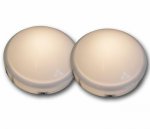Hi
I am an artist currently doing work with a group of dyslexic children for a literature festival. The work is based around dyslexia. I want to reverse a Simon says game to opposite colours to make the sequencing a little harder, for example, simon says ‘blue, blue, green’ the correct answer would be ‘green, green, blue’.. get it?
Here’s were I need help; I have an old super simon game and have just ordered the simon game kit from PICAXE education. They have told me I will be able to program the supplied controller chip to do what I want it to do myself.
I want to fix that chip into the circuitry of the old super simon game or adjust the amount of power going the PICAXE simon game to power larger bulbs rather than the LEDs with the game.
The chap at PICAXE said that this is basic stuff and would be easy for someone who has a basic knowledge of electronics. I don’t have even a basic knowledge! He said the best thing for me to do would to get on this forum and find some one near by (Manchester UK) to help me. He said I would most probably find someone out there! So, is there anybody there? please????
Thanks, Martin
I am an artist currently doing work with a group of dyslexic children for a literature festival. The work is based around dyslexia. I want to reverse a Simon says game to opposite colours to make the sequencing a little harder, for example, simon says ‘blue, blue, green’ the correct answer would be ‘green, green, blue’.. get it?
Here’s were I need help; I have an old super simon game and have just ordered the simon game kit from PICAXE education. They have told me I will be able to program the supplied controller chip to do what I want it to do myself.
I want to fix that chip into the circuitry of the old super simon game or adjust the amount of power going the PICAXE simon game to power larger bulbs rather than the LEDs with the game.
The chap at PICAXE said that this is basic stuff and would be easy for someone who has a basic knowledge of electronics. I don’t have even a basic knowledge! He said the best thing for me to do would to get on this forum and find some one near by (Manchester UK) to help me. He said I would most probably find someone out there! So, is there anybody there? please????
Thanks, Martin


